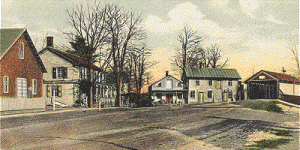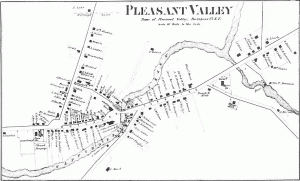What is now the hamlet of Pleasant Valley was in 1762 called Charlotte. At that time it was part of the Crum Elbow Precinct part of the Nine Partners Grant.
The Presbyterian Church was reestablished here in 1765 as the settlers moved west to take advantage of Wappingers Creek for water power. The church was incorporated in 1785 and was known as the Presbyterian Congregation of Pleasant Valley.
Malancton Smith who was a delegate to the Ratification of the U.S. Constitution at the court house in Poughkeepsie was a ruling elder in this church.
In 1788 Pleasant Valley became part of the Town of Clinton when the precincts were divided into townships.
The Methodist Church was originally built in 1827 on a site east of the American Legion Hall. The building was moved in winter to where we see it and recognize it as the Masonic Temple.
St. Paul’s Episcopal Church was built in 1842 by people from England who had come to work in the mill.
St. Stanislaus Roman Catholic Church began with services in a barn on the inn property across the street. Originally a small chapel was built on the location where the church now stands. The present building was erected in 1956.
The Quakers built their meeting house on the corner of North Avenue and Quaker Hill Road in 1810. This building is now owned by the Garage.
Amasa Angell was the first postmaster and he was appointed in 1812. Early on postmasters were appointed by the ruling political party, so from 1880 through 1897 the office seasawed between Edward Drake and Wright Devine, both proprietors of general stores.
Besides farming the other important early industry was milling. There were grain mills, cotton mills and fulling mills. The one mill to survive was Robert Abbot’s cotton and grain mill first built in 1808. It burned and was rebuilt and stands today, a derilict and victim of the times.
The early maps do not show names of roads and changes are they had different names anyhow. The Beers map of 1867 shows six schools in the hamlet as required by law at that time. The one location to survive has had three different buildings and is called Traver Road School.
There were three hotels on the main street. The only building still standing is The Roadhouse on the corner of Route 44 and Quaker Hill Road. When the railroad came through in 1871 there was an influx of summer visitors. They stayed at the hotels and at the farm houses turned summer boarding houses.
The town as been protected from fire by volunteer forces since 1907 at which time a charter was given to the John Knott Fire Company. The first fire house still stands to the east of the present one.
Main Street, Pleasant Valley, has been the location of the town’s library since 1903. It was first located west of Marine Midland Bank. It was moved to Route 44 at the junction of South Avenue in 1914. Its location now is the former manse of the Presbyterian Church.
There were more residences on the tree-lined street at the turn of the century and with its picket fences it had as much charm as Salt Point has today. It has been taking a swift move towards the next century as we watch.

